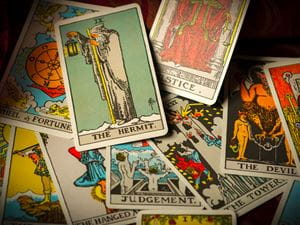
Tarot is a mystery. By all rights, a simple card shouldn’t be able to give us deep, spiritual insights into ourselves.
But for many, reading the cards has done just that.
Opinions vary on tarot. Some feel that these ornate cards are a legitimate way to discern the unknowable, a bridge between the material and the immaterial. The use of tarot for divination—an attempt to gain insight or knowledge from occultic ritual—began in the 18th century, and has regained popularity in recent decades.
Others feel that tarot opens gateways which should otherwise remain closed, and that the use of it can invite the presence of spiritual evil.
Still others merely see tarot as a meaningless diversion.
Many practitioners, though, see not only spirituality, but also a valid psychological aspect to the cards. Rachel Howe, a Brooklyn-based tarot reader describes the practice as a “discussion between the reader and the person whose cards are being read,” in an interview with Vogue. “Tarot is a tool,” she says, “and the real healing work is going to be done by the person. A lot of people describe tarot as a mirror, so it’s not like I’m pulling some secret out of you.”
Howe acknowledges the aura of mystique which surrounds tarot, but doesn’t believe that it has to be the secretive, esoteric affair that many make it out to be, bound by exclusive rules and superstitions, such as the idea that no one should ever buy their own deck. If you can’t buy your own, after all, how can you learn what tarot is really all about?
There’s no need for hazy descriptions here—tarot is all about making you think through your life and get in touch with your subconscious mind.
Not quite sure how this works? Then read on for a beginner’s guide to tarot.
The Cards
The first thing you’ll notice about tarot cards is that there are many different decks, each with its own unique style. There are decks that feature angels, Greek gods, animals, people, fairies, and crystals, just to name a few. The images are always archetypical, however, and are designed to be universally understood as basic parts of the human experience. For the purposes of this guide, we’re looking at the Sharman-Caselli deck, which comes with the “Beginner’s Guide to Tarot” by Juliet Sharman-Burke.
The second thing you’ll notice is that within each deck, there are a lot of cards in each deck—78, to be precise, and each one is utterly unique.
This can be overwhelming for a beginner, but if you take some quality time with your deck, you’ll come to learn that things are simpler than they appear.
The Sarman-Caselli deck is divided into the Major Arcana and the Minor Arcana. The 56 cards of the Minor Arcana each describe the influences in a person’s day-to-day life, and are divided into the Suit of Cups, the Suit of Wands, the Suit of Swords, and the Suit of Pentacles. Cups relate to feelings and relationships, Wands represent imagination and creativity, Swords relate to challenges, and Pentacles relate to finances and material aspects of life.
The 22 cards of the Major Arcana describe the important experiences and stages of a person’s life. The Fool, for example, represents the beginning of new cycle or adventure, and an optimistic, if somewhat naïve, view of the future.
Howe recommends pulling a random card each day and contemplating its meaning—this helps familiarize you with the cards on a deeper level. Attach your emotions to the image on the card, and try to feel it in a personal way. While an in-depth exploration of the meaning of each card is beyond the scope of this article, you can go a long way in learning tarot by simply feeling your way through each card’s symbolism.
The Reading
Before we get into how to read the cards, it’s important to remember Howe’s words: tarot is a tool to facilitate discussion. The spiritual experience of getting in touch with the subconscious mind is great at breaking down the barriers that people put up around themselves, their thoughts, and their feelings. When reading the cards, use your intuition to sense what the other person—or yourself—is thinking.
Don’t worry about trying to remember secret meanings and ancient symbols—as a beginner, trust yourself to make your own connections for now.
One of the most basic spreads in tarot is the three-card pull, and so we’ll start with this, which is a quick and easy way to start your first tarot reading!
The three-card pull involves drawing three cards that represent the past, present, and future of the person being read. To begin, have the person being read ask a question about a life issue or problem they’re currently experiencing. After this, have them divide your cards into three equal piles facing down, and have the other person turn over the top card of each pile.
The first card will represent issues from the past that may be contributing to the current problem. The second card will represent events in the present which may be causing issues. The third will show possible outcomes and resolutions for the issue.
The focus here should be not only what each card represents, but also upon the connections between the cards—how are the past, present, and future affecting one another? How might past hurts be causing present situations? How might it be creating a future outcome? Answering questions like these will help the person being read find their own answers.
In short, have a discussion!
And that’s it. You’ve done your first tarot reading. If you want to delve deeper into the possible meanings of each card, there are numerous resources to get you started, such as, as we’ve said, the “Beginner’s Guide to Tarot” by Juliet Sharman-Burke.
A Gateway to the Mind
Whether you feel that tarot readings are spiritual, psychological, or just for fun, there’s always something to be gained from delving into the underlying thoughts and assumptions which affect our daily lives.
Tarot is a gateway to this part of the mind, and so a reading is a great way to connect—both with another person, and with yourself.

